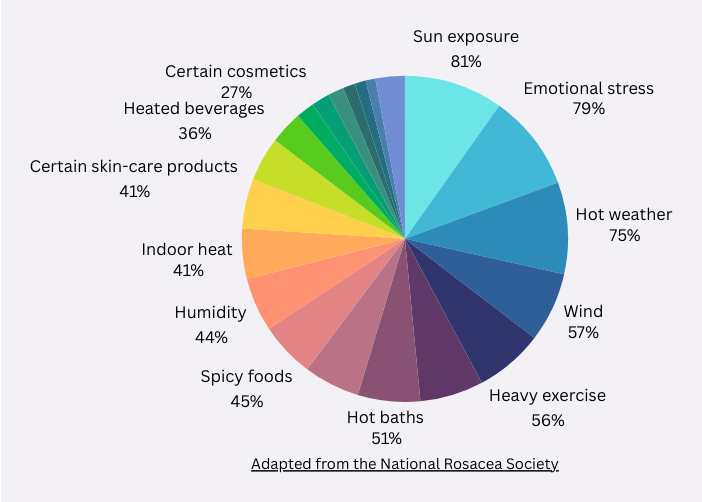
Understanding and managing Rosacea at Lala’s Electrics
What is Rosacea?
Rosacea is a common, long-term skin condition that primarily affects the central face (cheeks, chin, nose and central forehead). Rosacea is multifarious in nature, which means symptoms and types of rosacea vary greatly between individuals (particularly between ethnicities). However, it typically begins with a tendency to flush more easily and can progress to persistent redness, visible blood vessels, enlarged pores, small red bumps (papules) and pus-filled spots (pustules). While the exact cause of rosacea is unknown, various factors such as genetics, environmental triggers, and inflammation are believed to play a role.
While many hope for a permanent solution, currently, rosacea is considered a chronic condition that requires ongoing management rather than a cure. However, with consistent and appropriate treatment, the severity and frequency of flare-ups can be significantly reduced, and the skin's appearance can be greatly improved.
Recognising the Signs of Rosacea
What Rosacea looks like:
Persistent Facial Redness: Often in the central face (cheeks, nose, chin, forehead).
Flushing: Frequent blushing or flushing that can last longer than usual.
Visible Blood Vessels (Telangiectasia): Small, thread-like red lines visible on the skin's surface.
Papules and Pustules: Small red bumps and pus-filled spots that can resemble acne, but without blackheads or whiteheads.
Thickening Skin (Rhinophyma): In some cases, the skin on the nose can thicken, causing it to appear enlarged and bulbous (more common in men).
What Rosacea feels like:
Skin Sensitivity: Skin that feels easily irritated, stings, or burns.
Eye Involvement (Ocular Rosacea): Dry, irritated eyes, watery eyes, redness, and a gritty sensation. This can be one of the earliest signs of Rosacea.
Hot: People with Rosacea will often feel an uncomfortable level of heat in the skin, particularly after being exposed to a trigger.
*It’s important to note that not everyone with Rosacea will experience all of these symptoms.
What is a Rosacea trigger?
Rosacea is often characterised by periods of remission and flare-ups. Triggers are something we come into contact with that can induce a rosacea flare up. Triggers vary from person to person and understanding your personal triggers is key to minimising these flare-ups. This is a chart shows common triggers and the percentage of people with rosacea they affect:
Managing Rosacea Through Homecare
Because common ingredients and formulations bought over the counter can be potential triggers for rosacea, using the correct products at home is essential to effective management. ZO Skin Health offers a range of medical-grade skincare products specifically formulated to address the underlying factors contributing to rosacea, with multiple patented formulations which have been clinically shown to visibly relieve multiple symptoms of rosacea and redness prone skin.
Having worked with ZO Skin Health since 2021, Lauren will be able to assess your specific skin concerns and recommend a personalized ZO Skin Health regimen tailored to your individual needs and the severity of your rosacea during your consultation. Consistent use of these targeted products is crucial for long-term management and maintaining healthy skin.

At the beginning of rosacea management programs, in clinic treatments are often useful to enhance the effects of the homecare products and reduce the severity of rosacea sooner. Lauren has created the following treatment plan options as a starting point - aimed at reducing the severity of rosacea symptoms and restoring long term skin health.
Rosacea Management Program (3 months)
1 hour consultation with skin analysis
ZO Skin Health Skin Normalising System
Heliocare SPF
3 x Monthly in-clinic facial treatments
*homecare products will last approx. 10-12 weeks with correct usage
£550
Rosacea Management program (6 months)
1 hour consultation with skin analysis
ZO Skin Health Skin Normalising System
Heliocare SPF x2
6 x Monthly in-clinic facial treatments
*homecare products will last approx. 5-6 months with correct usage
£970
Dermalux Medical LED Booster Add On
Add 12 x Dermalux Flex MD LED standalone treatments to a Rosacea program to accelerate healing and deliver results in a faster timeframe.
For best results treatments are to be under taken approx. twice per week, over a 6-8 week period alongside either the 3 or 6 month Rosacea program.
£710




